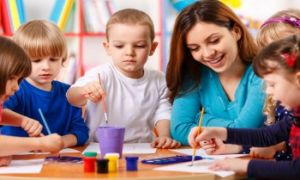

This wonderful activity which involves the salt dough preparation and then making of flowers using them and then making magnets with these flowers is very interesting. Though a long process, children will enjoy doing it for their mothers. To start with the activity, you can simply ask the children if they could correlate their mums with flowers. Let them speak out and say what they find common in both – the flowers and their mums. This will build their capacity to form sentences and speak out their thoughts. At the same time, we are introducing them to the activity as well.
This STEAM activity is a great project. It uses shapes, gravity and movement to create art with some awesome colours. Children will learn to create a roly-poly art using a fun technique with balls. Children will begin to understand explore its effects and use it to create a colourful piece of art.
Wassily Kandinsky was a Russian artist, printmaker and art theorist whose works were among the first to herald the modernist movement in art. Since childhood, he was deeply fascinated by colour and shapes and this is reflected over the many artistic phases of his own career. The following provides information on Wassily Kandinsky's art experiences that can be created by children.
Salvador Dali was a famous Spanish artist known for being unconventional in both his creations and appearance. His paintings, sculptures and films often have a dream-like quality about them, often because the bizarre landscapes or actions depicted cannot happen in the real world. This led to his art being described as Surrealism. Though such terms might sound rather highbrow, the art can be surprisingly conducive to working with children because of the very lack of logical possibility. Here are a few ways that you can explore Salvador Dali with your learners in early childhood settings.
Jackson Pollock was an American artist who painted in the abstract expressionist style. He is best known for works created by dripping and splashing paint on a large canvas that would lie flat on the floor. Additionally, he would often use dance-like movements when splashing colour on the canvas - a method that came to be known as action painting. Here are a few ways that you can explore Jackson Pollock with your learners in early childhood settings.
One of the greatest French artists of the 20th century, Henri Matisse is known for his fluid use of colours and forms in paintings and sculptures. The following provides information on Henri Matisse's art experiences that can be created by children.
Considered one of the greatest artists of the 20th century, Pablo Picasso is famous for a style of painting known as Cubism. As opposed to traditional art which depicts three-dimensional figures as they might appear to a human eye – for example, the back of a human figure’s head or rear side of a house not being visible – cubism strove to represent all sides of a figure, often by breaking it up and re-assembling it in abstract and geometric form. Here are a few ways that you can explore Pablo Picasso with your learners in early childhood settings.
Oscar-Claude Monet was a pioneer of the French Impressionist style of painting. According to this, an artist’s impressions of a landscape or object are more important than how it really looks. Yet another feature of his art was the painting of the same scene many times in order to capture the changing of light and the passing of the seasons. The following provides information on Claude Monet's art experiences that can be created by children.
Andy Warhol was one of the most famous American artists of the latter half of the 20th century. Born Andrew Warhola in 1928 in Pennsylvania, he originally worked as a commercial artist, designing commercials and window displays for stores. He soon became famous as an artist in the Pop Art movement which uses images from popular cultures like advertising, comic books and other everyday objects. The following provides information on Andy Warhol's art experiences that can be created by children.
Creative arts offer children - through dance, crafts, music, art or drama – some of the most enjoyable ways to express their ideas and imagination. Along along with providing opportunities for freewheeling thinking, creative pursuits bring many developmental and learning benefits as well.
 Here is the list of the EYLF Learning Outcomes that you can use as a guide or reference for your documentation and planning. The EYLF… Read More
Here is the list of the EYLF Learning Outcomes that you can use as a guide or reference for your documentation and planning. The EYLF… Read More
 The EYLF is a guide which consists of Principles, Practices and 5 main Learning Outcomes along with each of their sub outcomes, based on identity,… Read More
The EYLF is a guide which consists of Principles, Practices and 5 main Learning Outcomes along with each of their sub outcomes, based on identity,… Read More
 This is a guide on How to Write a Learning Story. It provides information on What Is A Learning Story, Writing A Learning Story, Sample… Read More
This is a guide on How to Write a Learning Story. It provides information on What Is A Learning Story, Writing A Learning Story, Sample… Read More
 One of the most important types of documentation methods that educators needs to be familiar with are “observations”. Observations are crucial for all early childhood… Read More
One of the most important types of documentation methods that educators needs to be familiar with are “observations”. Observations are crucial for all early childhood… Read More
 To support children achieve learning outcomes from the EYLF Framework, the following list gives educators examples of how to promote children's learning in each individual… Read More
To support children achieve learning outcomes from the EYLF Framework, the following list gives educators examples of how to promote children's learning in each individual… Read More
 Reflective practice is learning from everyday situations and issues and concerns that arise which form part of our daily routine while working in an early… Read More
Reflective practice is learning from everyday situations and issues and concerns that arise which form part of our daily routine while working in an early… Read More
 Within Australia, Programming and Planning is reflected and supported by the Early Years Learning Framework. Educators within early childhood settings, use the EYLF to guide… Read More
Within Australia, Programming and Planning is reflected and supported by the Early Years Learning Framework. Educators within early childhood settings, use the EYLF to guide… Read More
 This is a guide for educators on what to observe under each sub learning outcome from the EYLF Framework, when a child is engaged in… Read More
This is a guide for educators on what to observe under each sub learning outcome from the EYLF Framework, when a child is engaged in… Read More
 When observing children, it's important that we use a range of different observation methods from running records, learning stories to photographs and work samples. Using… Read More
When observing children, it's important that we use a range of different observation methods from running records, learning stories to photographs and work samples. Using… Read More
 The Early Years Learning Framework describes the curriculum as “all the interactions, experiences, activities, routines and events, planned and unplanned, that occur in an environment… Read More
The Early Years Learning Framework describes the curriculum as “all the interactions, experiences, activities, routines and events, planned and unplanned, that occur in an environment… Read More

According to EYLF, scaffolding comprises of the educators’ decisions and actions that build on children’s...
See more...
ABC Kids has a range of free content for Early Childhood Educators to use with...
See more...
The structure and organisation of a learning environment can have immense impact on all aspects...
See more...© 2009-2024 Aussie Childcare Network Pty Ltd. All Rights Reserved.

